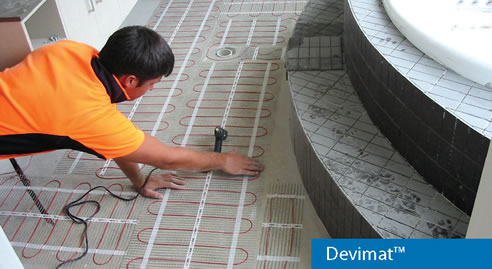Radiant Floor Heating Efficient and Economical from Devex Systems
Radiant Floor Heating: There's no question that the heating system you choose for your home will be a long term investment, so it's important to find a product that enhances the quality and comfort of your home and doesn't take away from it. Why Floor Heating? There are not many heating solutions that efficiently heat a room from the ground up. Most products only heat the air, increasing the likelihood of heat loss and causing energy bills to be higher than necessary, but thanks to the science of radiant heat, floor heating warms people and objects - not the air. This makes floor heating a much more efficient heating option and a safe bet for a gentle, lasting and uniform heat distribution across your entire floor surface. These virtually silent floor heating systems won't dry the air or circulate unwanted dust/allergens like forced air, portable or fan heaters. Common forms of traditional heating like conventional radiators and forced air systems can be inefficient due to the immediate heat loss that occurs as the heat cools to meet the existing air temperature. These systems do not distribute heat evenly throughout the room because the heat is usually released from a point location as opposed to uniformly throughout the floor surface, making it more challenging to reach a desired level of comfort for an extended period of time. Floor heating hinges upon the idea of invisible heat, meaning that heat can be felt not seen - so you can do away with any free standing heaters or vents that are an eye sore to your home and add unwanted clutter to your living space. Given that hot air rises, floor heating will heat the room from the ground up - a popular feature for those that tend to have cold feet and a great way to ensure comfortable, lasting warmth. This form of heating continues to grow in popularity in many parts of Australia thanks to the temperate climate in the mid to south-east and south-west parts of the country. Your Floor Heating Options - Electric or Hydronic There are two options for floor heating - Hydronic systems or Electric systems. Both systems are embedded under the floor structure. Depending on your budget and the application, you may find a particular system is more suited to your needs. Floor heating goes particularly well under hard floor surfaces making it ideal for bathrooms, kitchens and open entertaining areas. Anyone working on the hook up of your floor heating system, should be a licensed professional and must comply with all Australian electrical standards for electric floor heating and both electric and gas standards for hydronic floor heating. For more product-specific information on electric and hydronic floor heating systems, please visit the following websites:
www.devi.com.au Electric Floor Heating Electric floor heating is a great option for bathrooms and living spaces and is commonly used in retrofit projects. It is equally as suitable to both small and large areas from 1m2 upwards. They are extremely reliable and are incredibly flexible in terms of size, shape design and compatibility with different surface coverings. They are easily controlled and are operated by a simple "on" and "off" switch that is usually paired with a manual or programmable thermostat. How it works: Systems: In-Screed, In-Adhesive, In-Slab, Under Timber Depending on the application and personal preference of the home owner, either of these systems can be installed using loose cables or mats. There are generally three different systems that can suit particular design requirements:
Electric Heating Cables in SCREED BED
Electric Heating Cables in CONCRETE FLOOR SLAB ("storage system")
Electric Heating Cables in TILE ADHESIVE Electric Heating Cables WITH INSULATION FOR UNDER FLOATING TIMBER FLOORS - This system consists of heating cables that are fixed to an insulated panel that is specifically designed to spread the cable out at 100 mm centres. Recommended for use under manufactured floating timber floors, the panels polystyrene insulation ensures that any heat loss downwards is minimized and its aluminium surface ensures a uniform distribution of heat transfer to the timber floor. Click here to learn more about this system. * Polystyrene insulation is generally recommended at the time of any system installation to minimise heat loss and ensure the highest level of energy efficiency and cost savings. *It is important to review your state building code before installation to ensure the system complies with current regulations. For more information on electric floor heating systems, please click here
Application
Installation
Maintenance
Cost For more product-specific information please visit, www.devi.com.au
|
1800 636 091 5/83 Bassett Street, Mona Vale, NSW, 2103
|


 Radiant Heating Panel for Outdoor Use by
Radiant Heating Panel for Outdoor Use by Digital Programmable Thermostat for
Digital Programmable Thermostat for Hydronic Underfloor Heating for Timber
Hydronic Underfloor Heating for Timber Thermostat for Electric Floor Heating by
Thermostat for Electric Floor Heating by Ceiling Heating Panels for Wet Areas by
Ceiling Heating Panels for Wet Areas by Benefits and Features of Underfloor
Benefits and Features of Underfloor Hydronic Radiators for Homes by Devex
Hydronic Radiators for Homes by Devex Glare Free Outdoor Heater by Devex
Glare Free Outdoor Heater by Devex Benefits of Condensing Gas Boilers by
Benefits of Condensing Gas Boilers by Eco Friendly Heat Pumps by Devex Systems
Eco Friendly Heat Pumps by Devex Systems Mirror Foils for Bathrooms by Devex
Mirror Foils for Bathrooms by Devex Heating Cables for Timber Floors by
Heating Cables for Timber Floors by Features of Electric Underfloor Heating
Features of Electric Underfloor Heating Touch Screen Heating Control System by
Touch Screen Heating Control System by Hydronic Underfloor Heating NSW by Devex
Hydronic Underfloor Heating NSW by Devex Overhead Heating Panels by Devex Systems
Overhead Heating Panels by Devex Systems Heating Foils for Ceilings by Devex
Heating Foils for Ceilings by Devex Advantages of Underfloor Heating by
Advantages of Underfloor Heating by Thermostat for Electric or Hydronic
Thermostat for Electric or Hydronic Underfloor Heating for Bathrooms by
Underfloor Heating for Bathrooms by
